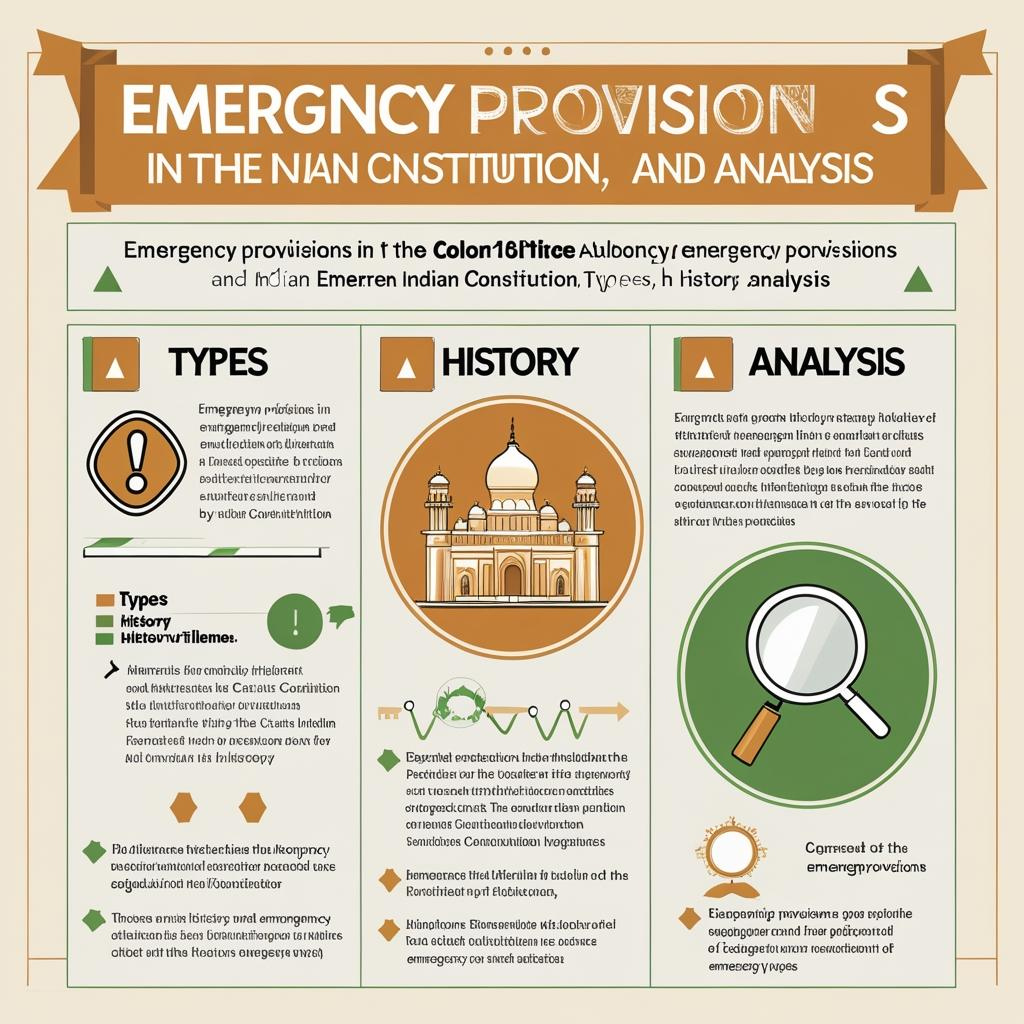1. Introduction
The Emergency Provisions in the Constitution of India (Part XVIII, Articles 352–360) empower the Union to meet exceptional situations that threaten the security, integrity, or financial stability of the nation. They allow for temporary suspension of certain democratic norms to restore normalcy.
However, such powers are extraordinary in nature and must be exercised with caution to prevent misuse. The 1975–77 National Emergency is often cited as a critical case study for balancing national security with civil liberties.
For UPSC aspirants, this topic is important for GS Paper II (Polity), with connections to GS Paper I (Post-Independence History) and Ethics (power accountability).
Also Visit – Best IAS Coaching in India
2. Historical Background
- Government of India Act, 1935: Contained provisions for emergencies — inspired by British constitutional practices.
- Constituent Assembly Debates: Dr. B.R. Ambedkar justified emergency powers as necessary to safeguard unity, but stressed they should be used only in grave situations.
- Comparative Influence: Drawn partly from Weimar Constitution (Germany) and the U.S. model of federal control during crises.
3. Constitutional Basis
Part XVIII of the Constitution contains the emergency provisions:
- Articles 352–360:
- Article 352 – National Emergency
- Article 356 – President’s Rule (State Emergency)
- Article 360 – Financial Emergency
Other related provisions:
- Article 83, 172 – Extension of Parliament/State Legislature terms during emergency.
- Article 358, 359 – Suspension of Fundamental Rights.

4. Types of Emergencies
4.1 National Emergency (Article 352)
Declared when there is a threat to:
- Security of India or any part thereof by war, external aggression, or armed rebellion.
Key Features:
- Can be proclaimed by the President on written advice of the Union Cabinet.
- Approved by both Houses of Parliament within one month.
- Duration: Six months, can be extended indefinitely with parliamentary approval every six months.
- Effects:
- Centre gets power to legislate on any matter (even in State List).
- Fundamental Rights under Article 19 automatically suspended.
- Article 20 and 21 rights remain enforceable (post-44th Amendment).
Instances:
- 1962 – Indo-China war.
- 1971 – Indo-Pak war.
- 1975 – Declared on grounds of “internal disturbance” (controversial).
4.2 State Emergency / President’s Rule (Article 356)
Proclaimed when:
- A state government cannot be carried on in accordance with the provisions of the Constitution.
Key Features:
- Based on Governor’s report or otherwise.
- Duration: Six months, extendable up to three years (with conditions).
- Parliament assumes powers of the State Legislature.
- Council of Ministers in the state is dismissed.
Misuse Concerns:
- Frequently used for political reasons before S.R. Bommai v. Union of India (1994) judgment, which limited arbitrary imposition.
4.3 Financial Emergency (Article 360)
Proclaimed when:
- The financial stability or credit of India or any part is threatened.
Key Features:
- Never invoked in India till date.
- Centre can direct states to reduce salaries, reserve money bills for presidential consideration.
- President can issue directions for financial propriety.
5. Procedure for Proclamation and Revocation
- Initiation: By Union Cabinet recommendation.
- Proclamation: By the President.
- Parliamentary Approval: Required within one month (earlier: two months before 44th Amendment).
- Continuation: Needs approval every six months.
- Revocation: By the President; does not require parliamentary approval.
6. Impact on Fundamental Rights
- Article 358: During National Emergency on grounds of war/external aggression, Article 19 rights are automatically suspended.
- Article 359: Allows suspension of enforcement of other Fundamental Rights (except Articles 20 and 21 after 44th Amendment).
7. Landmark Cases
- A.K. Gopalan v. State of Madras (1950): Early interpretation of personal liberty restrictions.
- ADM Jabalpur v. Shivkant Shukla (1976): Infamous ruling that habeas corpus could be suspended — later overruled.
- S.R. Bommai v. Union of India (1994): Limited misuse of Article 356; judicial review allowed.
- K.S. Puttaswamy v. Union of India (2017): Stressed proportionality even during restrictions.

8. 44th Constitutional Amendment (1978) — Safeguards Against Misuse
Post-Emergency reforms:
- Internal disturbance replaced with armed rebellion as a ground for National Emergency.
- Approval period reduced from 2 months to 1 month.
- Cabinet’s written recommendation mandatory.
- Articles 20 & 21 cannot be suspended.
- Extension of President’s Rule beyond 1 year requires national emergency or EC certification.
9. Criticism and Challenges
- Potential for Political Abuse:
- 1975 Emergency remains a warning.
- Weak Federalism:
- Centre can dominate states during emergency.
- Erosion of Civil Liberties:
- Media censorship, preventive detentions.
- Judicial Passivity:
- ADM Jabalpur case shows failure of judiciary under pressure.
- Vagueness in Terms:
- “Security of India” is open to interpretation.
10. Comparative Perspective
- USA: Federal emergencies have limited effect on states’ autonomy.
- Germany: Weimar Constitution’s emergency provisions were misused, leading to Hitler’s rise — a lesson for India.
- UK: Emergency powers are largely statutory and time-bound.
11. Reforms & Recommendations
- Punchhi Commission (2010):
- Limit President’s Rule to rare cases.
- Define grounds more precisely.
- Second ARC:
- Introduce prior judicial review for National Emergency.
- Strengthen parliamentary oversight.
- Encourage state capacity building to avoid emergencies.
- Ensure transparency in Cabinet advice.
12. UPSC Relevance
Prelims Focus:
- Articles 352, 356, 360.
- 44th Amendment provisions.
- Landmark judgments.
Mains Angle:
- GS Paper II: “Critically analyse the Emergency Provisions of the Indian Constitution. Do they strengthen or weaken the democratic fabric?”
- GS Paper I: 1975–77 Emergency as a historical event.
- Ethics: Misuse of power vs. constitutional morality.
13. Conclusion
Emergency provisions act as the constitutional shock absorbers of India’s democratic system. They equip the Union to respond to extraordinary threats but carry the inherent risk of authoritarian overreach.
The 1975 Emergency remains a stark reminder that while the Constitution allows temporary suspension of normal governance, such powers must always be exercised with utmost restraint, robust checks, and strong democratic accountability.
A mature democracy must ensure that emergencies protect the State without destroying the spirit of the Constitution.
For Answer Writing Techniques – Join FIRST IAS INSTITUTE

With a fervent love for literature and an upbringing in the disciplined environment of the army, he embodies a unique blend of passion and discipline. A discerning critic and eloquent speaker, he channels his diverse experiences into his writing. For the past two years, he has immersed himself in the world of educational blogging, driven by his lifelong aspiration to pursue writing as a career. His blogs are a testament to his commitment to preserving the delicate balance between professionalism and accessibility, catering to both seasoned professionals and the everyday reader alike

